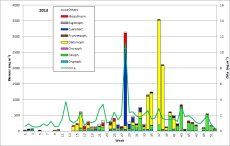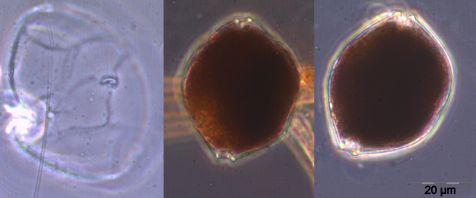
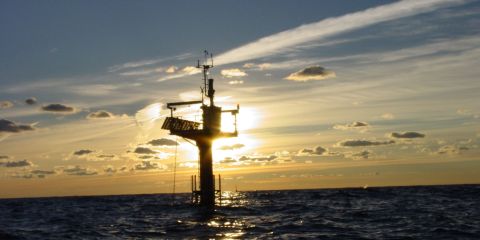
Phytoplankton development at the coastal station "Seebrücke Heiligendamm" in 2013
The Leibniz Institute for Baltic Sea Research conducts a coastal monitoring programme with weekly samplings at the jetty Heiligendamm (54°08,55' N; 11°50,60' E; 300 m off shore, 3 m water depth). The Department of Marine Biology analyses the surface samples, taken by means of a bucket, for phytoplankton composition and biomass and for chlorophyll a.
The phytoplankton biomass is determined by microscopical counting (UTERMÖHL method) and the chlorophyll a concentration by ethanol extraction and fluorometric measurement. Method instructions see http://helcom.fi/action-areas/monitoring-and-assessment/manuals-and-guidelines/combine-manual.
Phytoplankton counting was carried through by use of the counting programme OrgaCount and is based on the HELCOM-biovolume factors which are annually updated: http://www.ices.dk/marine-data/vocabularies/Documents/PEG_BVOL.zip (PEG_BVOL2013; basics see in Olenina et al. 2006). The analytical specifics of the chlorophyll a determination are published by Wasmund et al. (2006). According to the decision of the BLMP-subgroup “Quality Assurance” from 11.9.2008 we show here chlorophyll a data which are not corrected for pheopigments.

Microscopical analysis was not possible in some samples if they contained high sediment portions, caused by wind-induced sediment resuspension at the shallow station. It seems that the share of sediment-containing samples increased, probably because of diminishing water depth.
The results are shown in Fig. 1.

Despite gaps in the phytoplankton data series, we think that phytoplankton biomass was generally low in January and February 2013, as suggested by low chlorophyll-a-concentration <1 mg/m3.
At the beginning of January, Cryptophyceae (Teleaulax spp., Hemiselmis sp., Plagioselmis prolonga) were dominant, but after this, dinoflagellates (Ceratium tripos, Gymnodiniales) gained relatively more importance. Skeletonema marinoi (Image 1) dominated on 5.3.2013 (week 10). Because of a three-weeks data gap it is not sure if this diatom formed a spring bloom. The moderate chlorophyll peak in week 12 suggests that a bloom was there. If this bloom was formed, as usual, by diatoms which are generally poor in chlorophyll, the biomass could have reached much higher values than suggested by the rather low chlorophyll peak (cf. chl:biomass ratio found in week 37; see Fig. 1). At least, we found dominating Skeletonema marinoi still after this data gap. This species was replaced by Chaetoceros wighamii (Image 2) on 9.4.2013 (Week 15) already. Chaetoceros wighamii reached its maximum on 16.4.2013 with 161 mg/m3, besides other Chaetoceros species, that added 147 mg/m3.
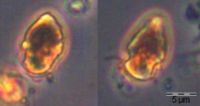
Only after the decrease of these diatoms, the ciliate Mesodinium rubrum could grow slightly. Usually it formed much higher biomass in spring.
The Euglenophyceae Eutreptiella braarudii, surprisingly strong in 2012, was unimportant in 2013. Also Dictyocha speculum, frequently dominating in previous spring periods, could be found only with few cells in 2013. The diatom Achnanthes taeniata, which formed a bloom in 2011, was rather rare. It reached an abundance of 41.000 cells/L on 23.4.2013, but due to its small cell size its biomass accounted for only 8 mg/m3. Remarkable is also the low appearance of dinoflagellates. They were mainly represented by Heterocapsa rotundata (Image 3) in week 21 and 22. The phytoplankton biomass is rather low compared with the chlorophyll-a-concentration in these two weeks because biomass is strongly underestimated as many picoplanktonic cells <2µm appeared, that are not included in the microscopical counting procedure.

In general, the spring bloom was low in 2013. As rather common, it could have been formed by the diatom Skeletonema marinoi, a species that was called Skeletonema costatum or Skeletonema sp. in previous years. Important spring species of previous years, as Mesodinium rubrum, Dictyocha speculum, Eutreptiella braarudii or Achnanthes taeniata were of low importance in spring 2013. Also the frequently observed succession from diatoms to dinoflagellates was only poorly visible in 2013.
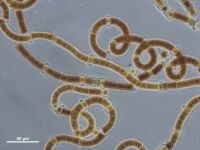
Weeks 24 and 25 (11.6. and 18.6.2013) represent the shift from the spring to the summer situation marked by a further, late appearance of spring diatoms (Skeletonema marinoi, up to 226 mg/m3) and the simultaneous slow increase of typical summer population, especially the nitrogen fixing cyanobacteria Aphanizomenon sp. (Image 4) and Nodularia spumigena (Image 5). The biomass peak of Nodularia spumigena (2060 mg/m3) is already reached on 9.7.2013 (Week 28), accompanied by Mesodinium rubrum (472 mg/m3) and Aphanizomenon sp. (336 mg/m3). This high biomass cannot have grown within one week. As Nodularia is strongly buoyant, it accumulates at the water surface under low-wind conditions and can easily be rounded up to patches and displaced. Our sampling procedure by a bucket leads to an overrepresentation of such surface accumulations. Just like the quick emergence, also the quick disappearance indicates that this high biomass is caused by wind-induced transportation of surface patches.
It has to be noted that our data do not reflect a strange condition. Strong cyanobacteria blooms were also noticed in other regions of the coast of Mecklenburg-Vorpommern. The water quality was impaired. In fact, Nodularia contains the toxine Nodularin. Samples from the monitoring cruise from July 2013 had a content of 22 µg Nodularin per g dry mass (analysis by Food GmbH Jena).
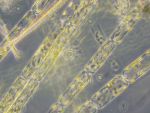
After a strong reduction of the biomass of cyanobacteria and Mesodinium rubrum by the 16.7.2013 (Week 29), dinoflagellates (Ceratium tripos, Alexandrium pseudogonyaulax) and diatoms (Dactyliosolen fragilissimus, Image 6) developed. Alexandrium pseudogonyaulax (Image 7) reached its maximum with 293 mg/m3 on 7.8.2013 (Week 32). That means, after its first finding in the year 2010 it gains continuously importance. Since week 34, Dactyliosolen fragilissimus has strongly grown. It formed a bloom on 10.9.2013 with a peak value of 3159 mg/m3 and was accompanied by only two main components: Ceratium tripos (Image 8) and Coscinodiscus granii (Image 9). These accompanying species are the typical autumn species.
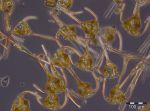
The low value from week 39 is an underestimation as a quantitative analysis of this sample was not possible because of high sediment contents. Only the information that diatoms are dominating can be extracted. On 1.10.2013 (week 40), the bloom of Dactyliosolen fragilissimus has disappeared. Ceratium tripos was dominant at that date whereas it vanished already one week later and was replaced by Coscinodiscus granii. This replacement is not a natural succession, but an indication of the drift of different water bodies along the sampling station. Ceratium tripos is typical for the haline water of the western Baltic (salinity of 16.6 on 1.10.2013) while Coscinodiscus granii originates from the Baltic Proper (salinity of 8.3 on 8.10.2013). Ceratium tripos reaches its peak on 22.10.2013 with a biomass of 639 mg/m3. However, this peak is much lower than in some other years, e.g. 1120 mg/m3 on 9.10.2012.
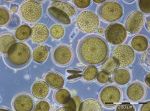
An autumn diatom bloom, as found in 2010, was absolutely absent in 2013. Very late diatom blooms appeared in the years 2008 and 2009 and led to a hypothesis that the vegetation period is extending. In fact we found an autotrophic phytoplankton biomass of 537 mg/m3 and a chlorophyll-a-concentration of 1.96 mg/m3 on 10.12.2013 (Week 50), but this is too low to support the hypothesis of an extended vegetation period.
Summarizing we noticed that the phytoplankton samples contained increasingly sediment and some of them could not by quantitatively analysed anymore. Data gaps could be bridged nicely by chlorophyll data. It seems that the spring bloom 2013 was only weak. An autumn bloom was lacking completely. However, an exceptionally strong cyanobacteria bloom appeared shortly at the beginning of July already. A diatom bloom of Dactyliosolen fragilissimus developed in September.
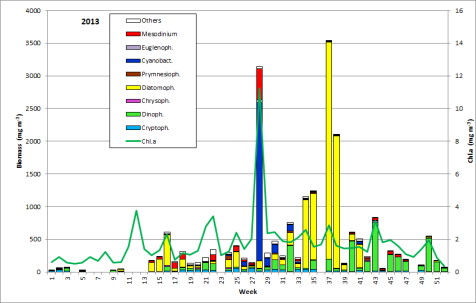
Acknowledgement
We thank the colleagues of the department Marine Chemistry for their cooperation and especially the colleagues of the department Biological Oceanography, Anja Hansen and Annett Grüttmüller, for their participation to the sampling tasks.
References:
Olenina, I., Hajdu, S., Andersson, A.,Edler, L., Wasmund, N., Busch, S., Göbel, J., Gromisz, S., Huseby, S., Huttunen, M., Jaanus, A., Kokkonen, P., Ledaine, I., Niemkiewicz, E. (2006): Biovolumes and size-classes of phytoplankton in the Baltic Sea. Baltic Sea Environment Proceedings No.106, 144pp.
http://www.helcom.fi/Lists/Publications/BSEP106.pdf
Wasmund, N., Topp, I., Schories, D. (2006): Optimising the storage and extraction of chlorophyll samples. Oceanologia 48: 125-144.
IOW, 25.03.2014
Dr. Norbert Wasmund,
Susanne Busch,
Christian Burmeister,
Regina Hansen.
Leibniz Institute for Baltic Sea Research Warnemünde (IOW),
Seestr. 15,
D-18119 Rostock-Warnemünde
Corresponding author: Dr. Norbert Wasmund
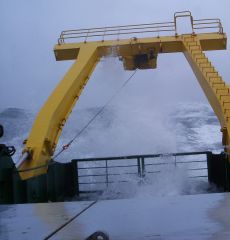
State of the Baltic Sea
- Annual Reports on the state of the Baltic Sea Environment
- Cruise Reports
- Data from the autonomous measuring stations
- Development of the suboxic and anoxic regions since 1969
- Baltic Thalweg transect since 2014
- Algal blooms at Heiligendamm since 1998
- "Major Baltic Inflow" December 2014
- "Major Baltic Inflow" January 2003
- Baltic saline barotropic inflows 1887 - 2018
- Further Reading
